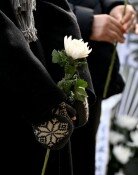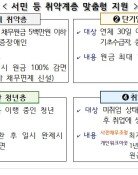History Shows That Dokdo Belongs to Korea
History Shows That Dokdo Belongs to Korea
Posted August. 24, 2005 03:01,
Professor Li Jin-Mieung, who is currently teaching Korean at both the University of Jean Moulin - Lyon 3 and the University of Paris VII in France, is regarded an exemplary case of successful Koreans in France. The fact that he became a tenured professor in France as a foreigner makes the claim true. Moreover, he received a Higher Degree Research (HDR) certification five years ago from the French government. In short, that means he has reached the highest position as a professor in France. That was 30 years after he arrived at France in 1971 as a student.
As his titles show, his main job is teaching Korean to French students and directing students who want to earn a doctorate degree in Koreanology. However, in Korea, he is more well known as a Dokdo researcher since he has put a lot of effort in order to find Dokdo-related materials, and he has ceaselessly written theses and published books. Scouring for old documents and maps, something he started 10 years ago out of curiosity, has taken precedence over his main job.
Professor Li made a publication titled, Dokdo, A Geographical Rediscovery (Sam-in) earlier this month. The book is a revision of its first edition published in 1998, adding newly found maps and data. The book contains newly discovered maps, which verify the fact that Dokdo belongs to Korea. One of the maps is the map Joseon Jeondo, believed to be made between 1550 and 1600, in which Dokdo is located left of Ulleungdo, and the two islands are very close to the Korean peninsula. The professor explained, There were some misunderstandings about the location of Dokdo, adding, However, the fact that Dokdo is located between Ulleungdo and the mainland and the two islands are drawn close to each other mean that the sovereignty of those islands belongs to Korea.
Another map, Yeojido, estimated to be produced in the late 17th Century, is considered the oldest map that marks the exact location of Dokdo and Ulleungdo. Besides that, the professor introduced the French World Atlas (1959) using the name, Tok Do and a map of National Geographic made in 1971 that contains Tok Do for the first time in its publications.
In an interview held at his home near Paris on August 22, the professor made an evaluation about his new book, saying, That is the final edition that does not need to add anything more. In his living room and study, various maps from all ages and countries were displayed here and there. He said that he spends a great proportion of his salary on buying maps and necessary materials.
He said, I started having an interest in and paying attention to the disputes surrounding Dokdo while I was taking an international law lecture of the diplomatic studies department when I was a university student. But I did not want to dig up Dokdo issues at that time, adding, I just intended to find some related data as I was abroad. He began to dig into the archives of French Navy, the French national archives center, and the archives at the Bibliotheque Nationale (the French national library). Sometimes, he visited a local archive after he got some hints from those places.
He also carried out naming research for East Sea. He said, The more I found documents, the more deplored I was. Since he found the fact that two thirds of western maps produced until the 18th century marked the eastern sea of Korea as Korean Sea, but from the 19th century, the name was replaced with Sea of Japan. He concluded, That was because of Koreas weak national power.
Professor Li explained, However, academic circles in Korea and the Korean government have actively responded about the issue from the 2000s, so errors have been corrected.
He referred to the 2005 world map by National Geographic as a good example. The map uses Sea of Japan and Korean Sea together. He argued that Korea even has to try to lobby organizations in the world to use the two names together if Sea of Japan has already taken hold.
Now he is about to end his research about Dokdo since he thought that there would be no more relevant materials having values deserving research. Meanwhile, he will continue his study about East Sea.
He met his wife, Yoko Ishihi (62), from Japan when he was a student. They married in 1979 when both took classes in Sorbonne University in France.
Ms. Ishihi is giving lectures on Japanese at several Grandes Écoles (educational center for professional elites in France), including the École Polytechnique in Paris. To the question asking about her opinions as a Japanese over Professor Lis research, she replied, He is doing research out of scholastic interests so I do not say something about his study.
Dong-Keun Keum gold@donga.com






